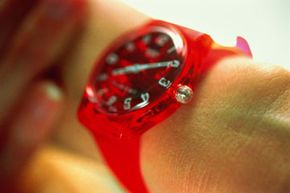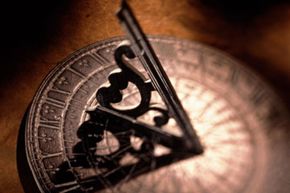As you might expect, early humans didn't wear watches. And they didn't really need them, either, since the nomadic hunter-gatherer lifestyle didn't require them to catch commuter trains or keep track of billable hours for clients. But the development of civilization and the division of labor put more pressure on humans to function together efficiently. Sundials, which measured shadows cast by the sun, were an early innovation. The Egyptians, who were concerned with keeping time at night so their priests would know when to perform rituals, invented the water clock -- basically, a giant vase with a hole in the bottom, which measured hours in drips [source: Woods]. In Medieval Europe in the 1300s, the advent of mechanical clocks made even precise timekeeping feasible. The first mechanical clocks were only accurate to within 15 minutes, but advances were made when the late-1600s Dutch scientist Christiaan Huygens developed a pendulum clock that lost just 10 seconds of time each day [sources: Lienhard, NIST]. In the 1850s, American Watch Co. in Waltham, Mass., marketed the first mass-produced spring-powered pocket watches, which enabled people to keep track of time wherever they went [source: NMAH].
But once everyone had clocks and watches, there was another, trickier dilemma: What time should everyone set them to? In 19th-century America, there were hundreds of local times, each determined by the big clocks at local courthouses or city halls, which in turn were set to the solar noon at each location. That meant that when it was noon in Chicago, it was 11:40 a.m. in St. Louis and 12:18 in Detroit. This posed a problem for the then-growing railroad industry, which needed a reliable standard for train schedules [source: Mansfield]. The railroads themselves set their clocks to celestial observations at the Harvard College Observatory, which they obtained via telegraph [source: NMAH]. To eliminate the discrepancy between local and railroad time, in 1883, railroad companies divided the U.S. into four time zones, each with a standard time, and compelled cities to adjust to them, or face economic isolation. People in Maine bristled at having to reset their clocks 25 minutes to what they derided as "Philadelphia Time," but eventually the whole nation was synchronized [source: Mansfield].
In the 20th century, scientists developed clocks set to the vibrations of crystals and even individual atoms, which made it possible to measure time in units so tiny -- down to the trillionths of a second -- that they were beyond normal, unaided human perception [source: NMAH]. That's why we all have the exact same time on our watches, and we're all precisely on time for our appointments today. Except that we're not. So, what's up with that?




